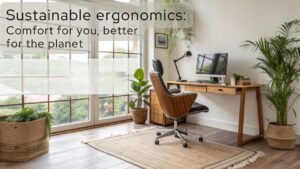Why Choose Sustainable Ergonomic Furniture for the Home Office?
At the crossroads of health and environmental stewardship sits your next furniture decision. You’re not just selecting a chair or desk for your home office—you’re choosing between chronic pain and comfort, between depleting resources and preserving them. Sustainable ergonomic furniture offers adjustable features that conform to your body while using recycled materials and non-toxic components. These pieces carry certifications that validate their environmental claims, making your investment count for both your wellbeing and the planet’s future.
Key Takeaways
- Look for adjustable chairs with lumbar support and desk height ranges of 27-46.5 inches to accommodate your specific body dimensions.
- Verify products have legitimate third-party certifications like BIFMA Level, Greenguard, or Cradle to Cradle to avoid greenwashing.
- Choose sustainable ergonomic furniture made from recycled plastics, responsibly sourced wood, and non-toxic materials with at least 30% recycled content.
- Consider the long-term value of quality pieces that last 7-10 years rather than focusing solely on initial cost.
- Select furniture with modular, replaceable components to extend product lifespan and reduce environmental impact through targeted repairs.
The Intersection of Sustainability and Ergonomics
As businesses and individuals increasingly prioritize both environmental responsibility and employee wellness, the intersection of sustainability and ergonomics has emerged as a critical consideration in furniture selection.
This convergence addresses dual concerns: reducing environmental impact while enhancing physical well-being.
Modern sustainable materials—including recycled plastics, responsibly sourced wood, and non-toxic components—now integrate seamlessly with ergonomic design principles.
This evolution responds to growing consumer awareness and market demand for environmentally conscious products that don’t compromise on comfort or functionality.
The fusion yields innovative solutions that minimize carbon footprints and deforestation while maximizing postural support and productivity.
When you invest in sustainable ergonomic furniture that embodies both sustainability and ergonomics, you’re not only supporting ecosystem health but also fostering human health through thoughtful, forward-thinking design choices.
Studies demonstrate that properly designed sustainable ergonomic furniture can significantly reduce musculoskeletal symptoms by up to 61% while maintaining environmental standards.
Integrating sustainable ergonomic furniture into home workspaces creates a healthier environment that reduces strain and enhances overall productivity while supporting long-term physical wellbeing.
Selecting ergonomically designed items with adjustable features ensures furniture can accommodate different body sizes and adapt to various tasks performed in your home office.
The right sustainable ergonomic furniture also contributes to greater job satisfaction by eliminating physical discomfort that can detract from work performance.
Key Features to Look for in Sustainable Ergonomic Chairs
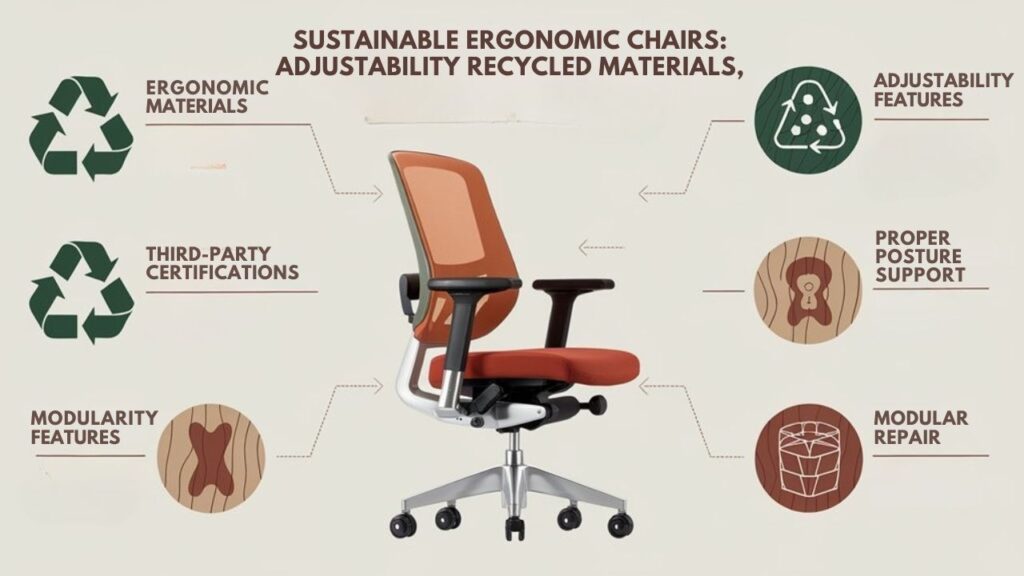
When selecting sustainable ergonomic chairs, you’ll need to balance thorough adjustability features with materials that minimize environmental impact.
Look for chairs with intuitive adjustment mechanisms that adapt to your unique body contours while verifying they incorporate at least 30% recycled content without compromising durability or comfort. Important features should include adjustable lumbar support that conforms to your spine’s natural curve. Quality ergonomic chairs offer 7-10 year lifespan with proper maintenance, making them a sustainable long-term investment. Innovative products like the Smart Ocean chair demonstrate how ocean plastic waste can be repurposed into high-quality office furniture without sacrificing ergonomic benefits.
Third-party certifications such as Environmental Product Declarations and Living Product Certification provide transparent verification of sustainability claims, helping you avoid greenwashing while ensuring your chair delivers both ergonomic support and ecological responsibility. Consider models that offer CarbonNeutral® certification to ensure lifecycle emissions are properly offset.
Adjustability Versus Sustainability
While furniture buyers often consider adjustability and sustainability as competing priorities, the modern ergonomic chair market successfully integrates both elements.
You’ll find that adjustability benefits extend beyond personal comfort—customizable features like height-adjustable armrests and tilt mechanisms greatly extend product lifespan by accommodating multiple users and preventing premature disposal.
The sustainability implications are considerable: chairs with modular, replaceable components reduce waste by allowing targeted repairs rather than complete replacement. Quality materials like breathable fabrics and high-density foam not only enhance comfort but also contribute to durability and longevity.
When evaluating options, compare the 62% recyclability rate of high-performing models against traditional alternatives. Looking for chairs with key certifications like Greenguard Gold or BIFMA Level ensures you’re choosing products that meet specific environmental and health standards.
Premium materials like aerospace-grade components and recyclable polypropylene deliver both durability and environmental responsibility. Ergonomic chairs demonstrate superior sustainability through their eco-friendly construction that minimizes environmental impact during manufacturing.
Manufacturers utilizing renewable energy in production processes further enhance sustainability credentials without compromising the ergonomic adjustability that drives productivity and physical wellbeing. Proper ergonomic design reduces health issues like back pain and neck tension commonly experienced with non-ergonomic furniture.
Certification Tells Truth
In today’s market saturated with misleadingly labeled “green” products, third-party certifications provide the only reliable verification of a chair’s environmental claims.
Sustainability misconceptions flourish when manufacturers self-report eco-credentials without verification. Look for BIFMA Level certification, which evaluates multiple sustainability criteria including materials and manufacturing processes.
For thorough assurance, verify chairs carry both sustainability and ergonomic certifications.
ANSI/BIFMA X5.1 confirms structural integrity while AFRDI Blue Tick guarantees ergonomic performance. Greenguard and Greenguard Gold certifications address indoor air quality concerns by verifying low-VOC emissions. The adjustable features of ergonomic chairs should include seat height, armrests, lumbar support, and recline tension for optimal customization to individual needs.
The certification importance extends beyond environmental validation—it guarantees holistic product quality.
Cradle to Cradle certification represents the gold standard, evaluating materials’ health impact alongside environmental considerations.
FSC Chain of Custody certification ensures wood components come from responsibly managed forests without being mixed with non-certified materials.
These third-party verifications cut through marketing hyperbole, delivering transparent evidence of a chair’s sustainable credentials.
Quality sustainable ergonomic furniture typically provides long-term value with proper maintenance, extending lifespan up to 15 years.
Eco-Friendly Desk Options for Your Home Office

Creating a sustainable home office begins with selecting an eco-friendly desk that combines environmental responsibility with ergonomic design.
Consider bamboo desks, which utilize fast-growing renewable resources while offering durability and aesthetic appeal. Alternatively, reclaimed wood options reduce waste by repurposing existing materials with unique character and minimal environmental impact.
Brands like Copeland and Urban Natural provide sustainably sourced wooden desks manufactured locally to reduce carbon emissions. MasayaCo implements a remarkable Seed to Seat process, planting more trees than they harvest for their minimalist desk designs.
When selecting your desk, prioritize nontoxic finishes that improve indoor air quality and support health benefits. Proper desk height adjustment can minimize strain on muscles and joints, promoting better posture throughout your workday.
For those prioritizing versatility, the Float Table offers effortless height adjustability for transitioning between sitting and standing positions throughout your workday.
Selecting sustainable ergonomic furniture with lumbar support helps maintain the natural curve of your lower back, preventing discomfort during extended work sessions.
For a complete eco-conscious workspace, integrate recycled desk accessories, cork desk mats, and energy-efficient lighting.
These sustainable options not only reduce your carbon footprint but often offer superior durability and customization possibilities—proving that environmental responsibility doesn’t require sacrificing functionality or style.
The Impact of Material Selection on Health and Environment

Material selection stands as a critical factor when choosing sustainable ergonomic furniture, directly impacting both environmental outcomes and human health. When you opt for wood-based products, you’re selecting materials with lower carbon footprints that continue sequestering carbon throughout their lifecycle.
The material impact extends to pollution reduction, with sustainable choices minimizing industrial emissions and diverting waste from landfills.
Health benefits are equally significant. Furniture made with low-VOC materials dramatically improves indoor air quality, reducing respiratory issues and headaches.
Indoor wellness begins with low-VOC furniture choices that safeguard respiratory health and minimize headache triggers.
Natural fabrics like wool, hemp, and organic cotton offer reduced allergen exposure compared to synthetic alternatives. Additionally, these sustainable materials typically contain fewer toxic chemicals, creating healthier workspaces that enhance overall wellbeing and productivity. Quality ergonomic chairs can reduce cervical spine pressure by up to 40% during extended periods of desk work.
Though potentially costlier initially, these investments yield long-term benefits through durability and improved occupant health. Proper ergonomic seating significantly improves spinal alignment, maintaining the spine’s natural S-curve alignment which is essential for preventing long-term musculoskeletal disorders.
Adjustability: The Core of Effective Ergonomic Design
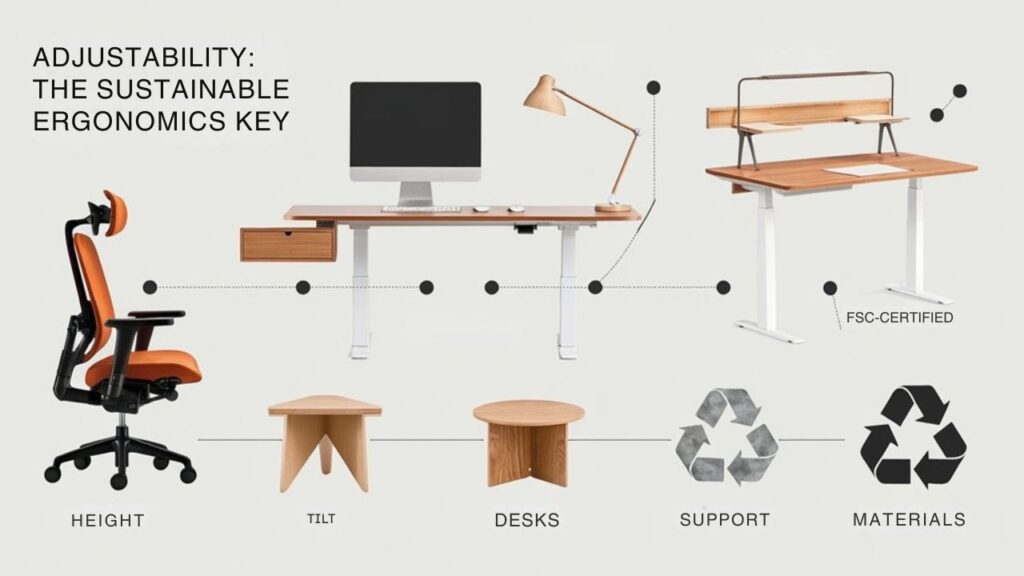
Adjustable sustainable ergonomic furniture offers you customization options beyond standard designs, letting you tailor settings to your specific body dimensions and work requirements.
When your furniture supports varied positions and movement throughout the day, you’re actively preventing musculoskeletal strain and enhancing circulation that static postures can’t provide.
Your ideal ergonomic chair or desk should seamlessly shift between different settings—standing, sitting, or reclining—making it adaptable to multiple environments from home offices to corporate spaces.
Most quality standing desks provide height adjustment ranges between 27 to 46.5 inches to accommodate users of various heights.
Implementing a standing desk converter can provide flexibility while requiring less space and investment than full standing desks.
Personalization Beyond One-Size
When selecting sustainable ergonomic furniture, the concept of personalization stands as a fundamental principle rather than an optional feature. Your body’s unique proportions demand customizable ergonomics that adapt to your specific requirements, not vice versa. Studies indicate that properly personalized workstations can increase productivity by up to 15%. Proper feet positioning with knees at a 90-degree angle creates ideal sitting conditions for long-term comfort and health.
| Personalization Factor | Benefits | Implementation |
|---|---|---|
| Height Adjustability | Reduces neck strain | Adjustable desk/chair height |
| Lumbar Support | Prevents lower back pain | Configurable back tension |
| Armrest Positioning | Minimizes shoulder tension | 3D adjustable armrests |
| Seat Depth | Optimizes circulation | Sliding seat mechanism |
The shift toward remote work has accelerated demand for personalized comfort solutions, with the ergonomic chair market projected to reach $19.12 billion by 2033. This growth reflects users’ recognition that one-size-fits-all furniture cannot adequately support diverse body types and working styles. Quality ergonomic chairs with adjustable lumbar support can significantly reduce back strain while supporting the natural curvature of your spine during extended work sessions.
Movement Supports Health
Although ergonomic design begins with proper posture support, movement integration represents the critical evolution in workspace health science. Your body isn’t designed for static positioning—it thrives with regular position changes.
Implementing adjustable workstations that shift between sitting and standing postures catalyzes significant health improvements. Standing desks specifically help improve posture and alleviate back discomfort often experienced with extended sitting periods. These dynamic setups reduce risks of deep vein thrombosis and cardiovascular conditions while enhancing circulation throughout your lower extremities.
The movement benefits extend beyond physical health—cognitive function improves with increased blood flow and oxygen delivery to the brain.
Modern sustainable ergonomic furniture facilitates this essential mobility through height-adjustable desks, swivel chairs with fluid mechanisms, and modular components that adapt to various work modes.
Taking regular breaks every 30 minutes for movement and wrist exercises helps maintain productivity while preventing musculoskeletal disorders.
Multi-Setting Adaptability
The core principle of effective ergonomic design resides in adaptability—furniture that adjusts to various body types, work environments, and changing tasks throughout the day.
When selecting sustainable options, prioritize desks that enable sitting-to-standing shifts, promoting better circulation while reducing sedentary health risks.
In shared workspace environments, choose furniture systems with quick-adjust capabilities that accommodate multiple user preferences without requiring complex reconfiguration.
Look for integrated height controls, adjustable armrests, and customizable lumbar support mechanisms that maintain proper ergonomics regardless of user physiology.
The most innovative adaptable designs offer compatibility with ergonomic accessories and provide built-in cable management systems to maintain organizational efficiency.
These multi-setting solutions preserve functionality whether in home offices or corporate environments, ensuring ergonomic benefits aren’t compromised when switching between work locations.
Proper ergonomic chairs with dynamic lumbar support help maintain the spine’s natural curve and significantly reduce the risk of developing back pain during extended periods of sitting.
Quality gaming chairs now feature massage functionality to help alleviate muscle tension during extended use while supporting proper posture alignment.
How Remote Work Is Reshaping Home Furniture Choices
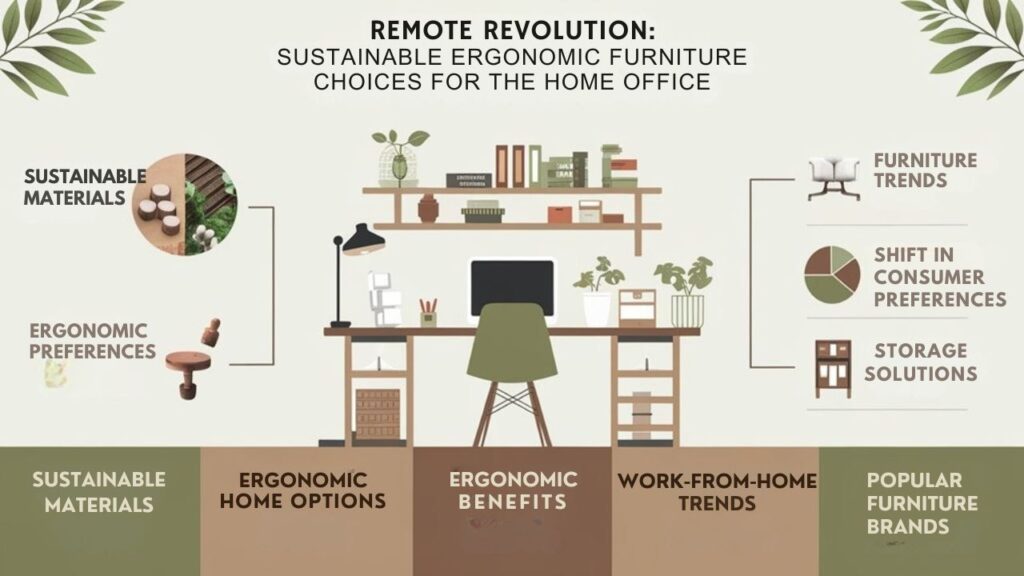
Remote work’s explosive growth has fundamentally transformed how consumers approach home furniture selection, with ergonomic considerations now taking center stage. You’re now prioritizing dual-purpose furniture that adapts to hybrid work models while aligning with sustainability goals. Standing desks have become particularly popular as they reduce back pain and increase productivity by up to 32%.
Home office trends indicate a significant shift in consumer preferences, with e-commerce furniture sales quadrupling during the pandemic. You’re investing in quality pieces that support long-term health and productivity.
| Furniture Type | Remote Work Impact | Consumer Response |
|---|---|---|
| Ergonomic Chairs | Reduced back strain | 55% sales increase |
| Adjustable Desks | Enhanced flexibility | Dominant in urban markets |
| Storage Solutions | Optimized space usage | Multi-functional designs preferred |
| Lighting Systems | Improved visual comfort | Smart integration demanded |
The residential built environment continues evolving to accommodate dedicated workspaces, as you seek furniture that shifts seamlessly between professional and personal environments.
Top Certifications for Truly Sustainable Furniture

To navigate the complex landscape of sustainable furniture, you’ll need to recognize credible eco-certifications that separate genuine environmental commitments from greenwashing.
Key certifications to prioritize include BIFMA Level (particularly Level 3), FSC for wood sourcing, Greenguard Gold for indoor air quality, and Environmental Product Declarations (EPDs) that provide transparent lifecycle assessments.
These third-party verifications guarantee your ergonomic furniture selections align with legitimate sustainability standards rather than merely responding to marketing claims that lack substantive environmental benefits.
Credible Eco-Labels Explained
Maneuvering the complex landscape of sustainability certifications can be overwhelming when selecting ergonomic furniture for your workspace. To guarantee certification transparency, focus on internationally recognized eco-labels with rigorous standards.
Cradle to Cradle (C2C) certification evaluates products across five critical categories: material health, reuse, renewable energy usage, water stewardship, and social fairness.
For air quality concerns, Greenguard-certified furniture guarantees minimal chemical emissions. The FEMB Level certification specifically addresses office furniture sustainability through extensive manufacturing evaluations.
The eco label importance can’t be overstated—these third-party verifications require facility inspections, supply chain audits, and ongoing compliance monitoring.
SCS Sustainable Choice offers tiered recognition (Silver to Platinum) based on environmental performance, while Fair Trade certification ensures ethical labor practices throughout production.
Beyond Greenwashing Claims
Steering beyond the misleading claims of greenwashing requires a disciplined approach to certification verification when purchasing sustainable ergonomic furniture.
Focus on credentialed standards like BIFMA Level 3 and Greenguard Gold, which employ rigorous third-party audits to validate ethical sourcing practices.
Prioritize manufacturers demonstrating thorough sustainable design through multiple certifications rather than single eco-labels.
The FSC certification guarantees responsible forest management, while Cradle to Cradle evaluates the complete product lifecycle.
For ideal indoor air quality, look for SCS and MAS Certified Green validations that restrict VOC emissions.
Scrutinize transparency instruments like Declare Labels that document material composition and origin.
Companies committed to supply chain transparency and take-back programs typically represent authentically sustainable options rather than superficial green marketing.
Balancing Budget With Long-Term Health Benefits

While many consumers view ergonomic furniture as a luxury expense, the careful balancing of initial costs against long-term health benefits represents a critical financial decision. A cost benefit analysis reveals that ergonomic design investments typically yield returns through reduced healthcare expenses and increased productivity.
| Option | Initial Cost | Long-Term Value |
|---|---|---|
| Premium Chairs | $500-1,000+ | Extensive support, 10+ year lifespan |
| Mid-Range | $200-500 | Essential adjustability, 5-8 year durability |
| Budget-Friendly | $100-200 | Basic ergonomics, requires DIY modifications |
You don’t need to stretch your budget for quality ergonomics. Consider second-hand premium models or timing purchases during sales events. Remember that even basic ergonomic furniture considerably outperforms standard options in preventing musculoskeletal disorders, potentially saving thousands in future medical costs.
Creating a Complete Ergonomic Workspace at Home
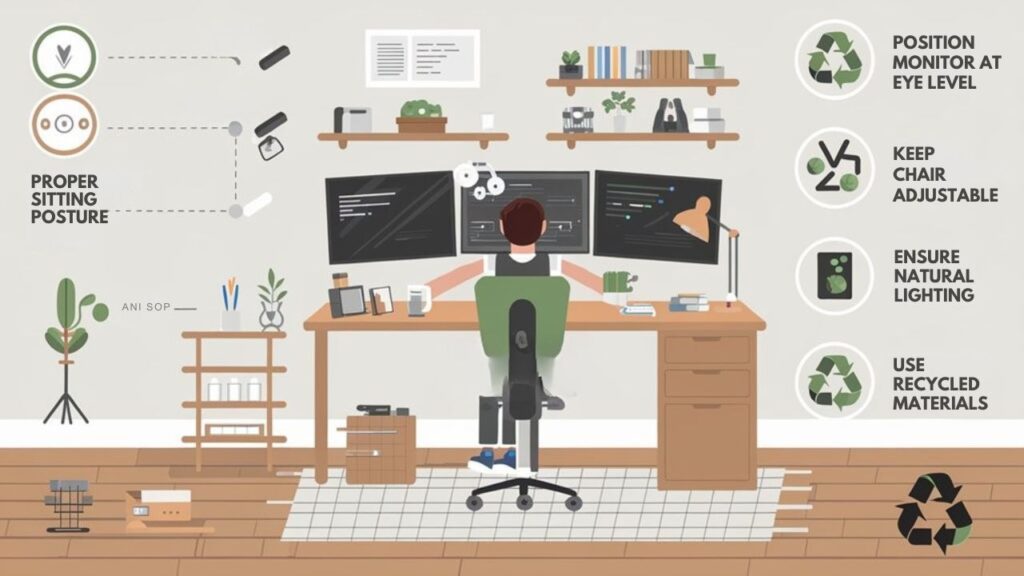
Building upon the economics of ergonomic furnishings, your home workspace deserves specific attention to detail.
Begin by optimizing your workspace layout to promote efficient workflow while reducing unnecessary movement. Position your monitor at eye level, an arm’s length away, and adjust your desk height to maintain elbows at 90 degrees when typing.
Invest strategically in ergonomic accessories that enhance comfort and prevent long-term health issues. Monitor arms offer flexibility for perfect screen positioning, while ergonomic keyboards and mice reduce wrist strain.
Strategic ergonomic investments pay dividends through enhanced comfort, precise positioning, and prevention of chronic injuries that diminish productivity.
Implement effective cable management systems to minimize visual clutter and create a distraction-free environment. Ensure adequate ambient lighting to reduce eye fatigue, and consider a footrest if your feet don’t rest flat on the floor.
This thorough approach creates a sustainable workspace that protects your health while boosting productivity.
Maintaining and Extending the Life of Your Sustainable Furniture

Maintaining your sustainable ergonomic furniture represents a critical investment in both environmental responsibility and long-term financial prudence. Proper maintenance enhances furniture longevity while reinforcing your commitment to sustainability through reduced consumption cycles.
Implement these evidence-based maintenance tips to maximize your furniture’s lifecycle:
- Establish a tiered cleaning protocol—daily dust removal, weekly spot treatments, and quarterly deep cleaning with material-appropriate solutions.
- Apply preventative treatments strategically—fabric protectors for upholstery and conditioning oils for wood and leather components.
- Rotate usage patterns to distribute wear evenly across all furniture pieces, particularly for high-traffic items.
- Document maintenance activities in a digital log to track interventions, evaluate effectiveness, and optimize your preservation strategy.
These systematic approaches will greatly extend your furniture’s functional lifespan while preserving its ergonomic integrity and sustainable value.
Frequently Asked Questions
How Do I Clean Sustainable Ergonomic Furniture Without Damaging Eco-Friendly Materials?
Use soap and water for daily eco-friendly cleaning. Avoid harsh chemicals that damage surfaces. You’ll preserve material integrity by applying vinegar solutions and soft brush vacuuming for regular maintenance.
Can Sustainable Ergonomic Furniture Be Customized for Specific Health Conditions?
Like a tailor crafts a perfect suit, yes, you’ll find sustainable ergonomic furniture can be specifically customized with health considerations driving the custom design process for your unique physical requirements.
What’s the Average Lifespan Difference Between Sustainable and Conventional Ergonomic Furniture?
You’ll find sustainable ergonomic furniture typically lasts 7-10 years longer than conventional options, thanks to higher-quality sustainable materials and enhanced furniture durability through superior manufacturing techniques and design principles.
Are There Tax Benefits for Businesses Purchasing Sustainable Ergonomic Office Furniture?
While traditional furniture depreciates slowly, sustainable ergonomic options offer immediate benefits through Section 179 tax deductions. You’ll maximize business incentives by writing off the full purchase cost in the acquisition year.
How Do Different Climates Affect Sustainable Materials in Ergonomic Furniture?
Climate impacts material durability considerably. You’ll find humidity affects bamboo and cork positively, while temperature fluctuations challenge natural fibers. UV exposure degrades many materials, necessitating climate-specific selection for ideal performance.
Conclusion
You’ll foster future functionality by selecting sustainable, supportive seating for your space. Properly prioritize products with proven performance parameters and pertinent environmental certifications. When you weigh wellness against waste, you’re making meaningful modifications that maximize musculoskeletal health and minimize material impact. Commit to conscientious consumption—your careful choices create comfort that conserves critical resources while cultivating a more capable, comfortable home workspace.

I am a retired software engineer with experience in a multitude of areas including managing AWS and VMWare development environments. I bought a relative a mini-PC a year ago and have become passionate about the technology and its potential to change how we deploy software.

